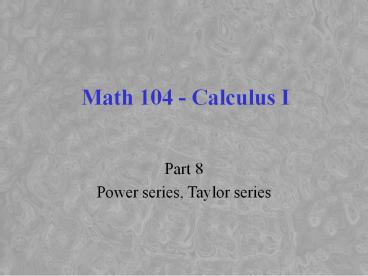Math 104 - Calculus I - PowerPoint PPT Presentation
Title:
Math 104 - Calculus I
Description:
Math 104 - Calculus I Part 8 Power series, Taylor series ... derived formulas and other tricks for finding them, and know them for a few functions. 4. – PowerPoint PPT presentation
Number of Views:516
Avg rating:3.0/5.0
Title: Math 104 - Calculus I
1
Math 104 - Calculus I
- Part 8
- Power series, Taylor series
2
Series
- First .. a review of what we have done so far
- 1. We examined series of constants and learned
that we can say everything there is to say about
geometric and telescoping series. - 2. We developed tests for convergence of series
of constants. - 3. We considered power series, derived formulas
and other tricks for finding them, and know them
for a few functions. - 4. We used the ratio tests to determine
intervals on which power series converge, and use
the other tests to check convergence at the
endpoints of the intervals.
3
Geometric series
- a/(1-r) a ar ar2 ar3 ...
- provided rlt 1.
- We often use partial fractions to detect
telescoping series, for which we can calculate
explicitly the partial sums sn
4
Tests for convergence for series of constants
- Fundamental divergence test (nth term must go to
zero for convergence to be possible) - Integral test
- Comparison and limit comparison tests
- Ratio test
- Root test
- Alternating series test
5
Power series
- f(x) a0 a1 x a2 x2 a3 x3 ...
- where an f(n)(0)/n!
- We know the series for ex, sin(x), cos(x),
- 1/(1-x), and a few related functions.
6
Convergence of power series
- Before we get too excited about finding series,
let's make sure that, at the very least, the
series converge. - Next week, we'll deal with the question of
whether they converge to the function we expect.
But for now, we'll assume that if they converge,
they converge to the function they "came from". - (Strictly speaking, this is not always true --
but it is true for a large class of functions,
which includes nearly all the ones encountered in
basic science and mathematics. This fact was not
fully appreciated until the early part of the
twentieth century.) - Fortunately, most of the question of whether
power series converge is answered fairly directly
by the ratio test.
7
Recall that...
- for a series of constants , we have that
the series converges (absolutely) if the the
limit of the absolute value of is less than one,
diverges if - the limit is greater than one, and the test is
indeterminate if the limit equals one. - To use the ratio test on power series, just leave
the x there and calculate the limit for each
value of x. This will give an inequality that x
must satisfy in order for the series to converge.
8
For the series for the exponential function...
9
Your turn...
- Calculate the series for the function sin(x) and
determine for which x the series converges.
10
Heres a more interesting example
11
What remains...
12
Final Conclusion
13
OK, your turn...
A. -1 lt x lt 1 B. -2 lt x lt 2 C. 1/2 lt x lt 1/2
D. -2 lt x lt 2 E. -1/2 lt x lt 1/2
14
One more...
A. -1 lt x lt 1 B. -1 lt x lt 1 C. 1 lt x lt 1 D. -1
lt x lt 1 E. 0 lt x lt 1
15
From these examples,
- ...it should be apparent that power series
converge for values of x in an interval that is
centered at zero, i.e., an interval of the form
-a, a , (-a, a, -a, a) or (-a, a) (where a
might be either zero or infinity). The interval
is called the interval of convergence and the
number a is called the radius of convergence .
16
Lets go back
To finding series of functions
17
The other way
18
Try this...
- Take the derivative of the series for sin(x) to
get
19
Integrate both sides of the geometric series from
0 to x to get
20
Negate both sides and replace x by (-x)
everywhere to get
21
Start from the geometric series again...
2
And substitute x for x everywhere it appears to
get
22
A challenge to think about...
- How to get the other one from previously
23
Application of Series
- 1. Limits Series give a good idea of the
behavior of functions in the neighborhood of 0 - We know for other reasons that
- We could do this by series
24
This can be used on complicated limits...
- Calculate the limitA. 0
- B. 1/6
- C. 1
- D. 1/12
- E. does not exist
25
Application of series (continued)
- 2. Approximate evaluation of integrals Many
integrals that cannot be evaluated in closed form
(i.e., for which no elementary anti-derivative
exists) can be approximated using series (and we
can even estimate how far off the approximations
are). - Example Calculate to the nearest 0.001.
26
We begin by...
27
According to Maple...
- The last series is an alternating series with
decreasing terms. We need to find the first one
that is less than 0.0005 to ensure that the error
will be less than 0.001. According to Maple - evalf(1/(7factorial(3))), evalf(1/(9factorial(4)
)),evalf( 1/(11factorial(5))) - evalf(1/(13factorial(6)))
.02380952381, .004629629630, .0007575757576
.0001068376068
28
Keep going...
- So it's enough to go out to the 5! term. We do
this as follows - Sum((-1)n/((2n1)factorial(n)),n0..5)
sum((-1)n/((2n1) factorial(n)),n0..5) - evalf()
.7467291967.7467291967
29
and finally...
- So we get that to the nearest
thousandth. - Again, according to Maple, the actual answer (to
10 places) is - evalf(int(exp(-x2),x0..1))
.74669241330
30
Try this...
- Sum the first four nonzero terms to approximate
- A. 0.7635
- B. 0.5637
- C. 0.3567
- D. 0.6357
- E. 0.6735































